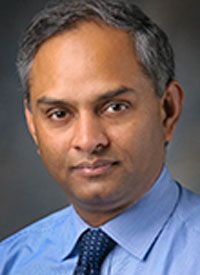Article
Expert Highlights Efficacy of KTE-C19 CAR T-Cell Therapy in Non-Hodgkin Lymphoma
Author(s):
KTE-C19, an investigational CAR T-cell therapy, recently demonstrated positive results for patients with chemorefractory aggressive non-Hodgkin lymphoma.
Sattva S. Neelapu, MD

Sattva S. Neelapu, MD
KTE-C19, an investigational CAR T-cell therapy, recently demonstrated positive results for patients with chemorefractory aggressive non-Hodgkin lymphoma, according to an interim analysis of the ZUMA-1 trial presented at the 2016 ASH Annual Meeting.
The production of a patient-specific CAR T-cell therapy typically requires 2 to 4 weeks of manufacturing and development after apheresis or blood draw. Patients then undergo a 3-day chemotherapy conditioning regimen, usually including cyclophosphamide with or without fludarabine. The CAR T-cell product is then infused within 3 days after conditioning.
KTE-C19, on the other hand, can be manufactured with a shorter turnaround time, according to Sattva S. Neelapu, MD.
“It’s important to note that this product could be manufactured in 99% of patients,” he said. “And the other important point to note is that, unlike most of the CD19 CAR T-cell therapies, this product could be manufactured with a short turnaround time of only 17 days.”
OncLive: Could you provide some background on this study?
In an interview with OncLive, Neelapu, an associate professor of Lymphoma and Myeloma at the University of Texas MD Anderson Cancer Center, discussed the efficacy of KTE-C19 in this patient population as well as next steps for further research of this agent.Neelapu: ZUMA-1 is the first pivotal multicenter trial of an anti-CD19 CAR T-cell therapy called KTE-C19 in patients with refractory, aggressive B-cell non-Hodgkin lymphoma. KTE-C19 is basically a genetically engineered T cell product that is trained to recognize the CD19 that is expressed on the surface of the tumor cells.
What were the most significant findings?
Once the patients had been screened and enrolled, they underwent a leukapheresis procedure to collect their T cells, and once this product had been manufactured, they received conditioning chemotherapy with cyclophosphamide and fludarabine for 3 days on days -5 to days -3. On day 0, they received the target dose of KTE-C19 at a dose of 2 million cells per kilogram. And following the infusion, the patients were observed in the hospital for at least 7 days to manage for side effects, and the first tumor assessment was done at 30 days.What we’re reporting here at this point is the prespecified interim analysis of the study. The prespecified interim analysis included patients who had at least 3 months of follow-up following the infusion. There were 51 patients with DLBCL, and what we observed in these 51 patients is the majority of them achieved a clinical response in the first month after the infusion. The best overall response rate was 76%, and the best complete response rate was 47%.
Were there any noteworthy adverse events?
Now in the combined cohort of cohorts 1 and 2, we had 62 patients. In these 62 patients, we observed the best overall response rate of 79%, and the complete response rate was 52%. So at this interim analysis, the study met its primary endpoint, with a P value of .0001.There are 2 common adverse events that we observed. One is cytokine release syndrome, and the second includes neurological side effects. The cytokine release syndrome typically manifests as fever and body aches, but a few patients may also develop dropping of blood pressure or hypoxia. But the majority of the cytokine release syndrome events were grade 1 or 2. Only 13% of the patients had grade 3 or higher cytokine release syndrome.
The majority of the neurological events were grade 1 or 2, and that could be tremors, or sometimes confusion, delirium, or encephalopathy. Twenty-nine percent of the patients had grade 3 or higher neurological events.
There were 3 patient deaths on the study, 2 of which were related to KTE-C19. One of those 2 patient deaths was due to hemophagocytic lymphohistiocytosis, and the second was due to cardiac arrest in the setting of cytokine release syndrome.
What would you say are the next steps following these results?
The majority of the side effects were completely reversible. They were managed either with supportive care or with tocilizumab (Actemra) or corticosteroids. In fact, we developed treatment algorithms that could be implemented across all 22 sites where the study was performed.These high response rates and durable complete response rates that have been observed in this product on this study—as well as some of the other previous studies done at single institutions with this product—suggest that this probably offers a potential treatment option for patients with these highly refractory lymphomas who have no other standard treatments available at this point.
But I think we still have a lot more that we want to do. We want to further improve the complete remission rates in these patients. We are planning for combination trials with checkpoint inhibitors such as anti¬—PD-L1 antibodies, and those trials have recently been initiated.
We’re also doing extensive biomarker analyses to further understand what the main drivers are for the cytokine release syndrome and the neurological events so we can manage them better. We’re also doing those biomarker analyses to try and understand why some patients don’t respond, and some progress after initial response, and that would help guide us in the future combination trials to further improve the outcomes of these patients.
I think it’s also important to note that this product could be manufactured in 99% of patients. And the other important point to note is that, unlike most of the CD19 CAR T-cell therapies, this product could be manufactured with a short turnaround time of only 17 days.









